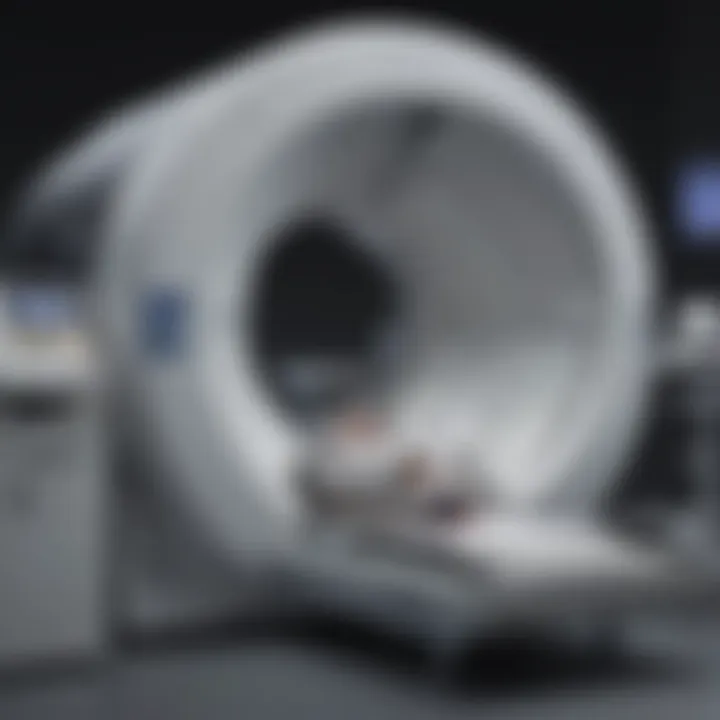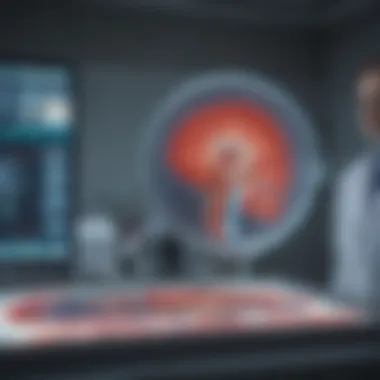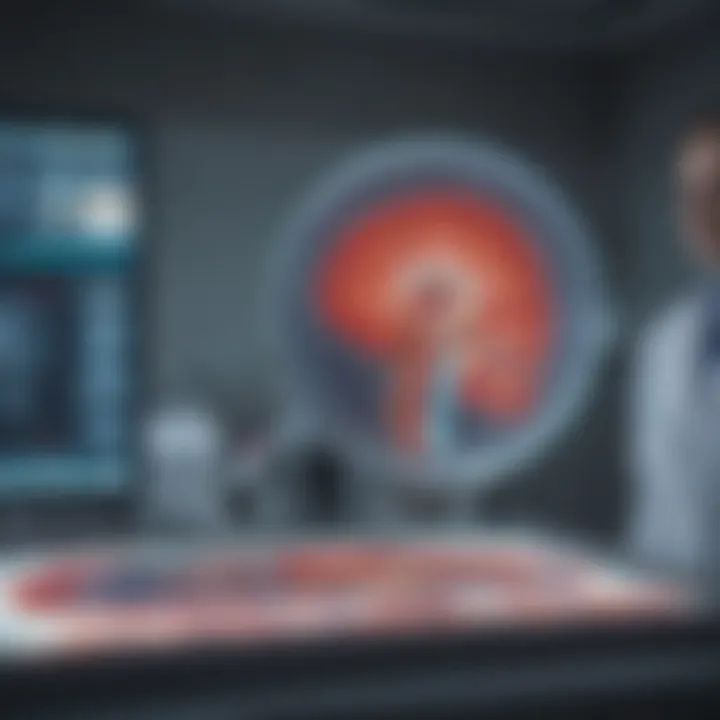Understanding PET Scan Machines: A Comprehensive Guide


Intro
Positron Emission Tomography (PET) is an advanced imaging technique that plays a crucial role in modern medicine. Understanding how PET scan machines function reveals their importance in diagnosing and monitoring diverse medical conditions. This article explores the intricacies of PET technology, its applications in various fields, and the future advancements that could reshape diagnostics.
As healthcare continues to evolve, incorporating innovative imaging modalities becomes essential. The PET scan is one such modality that not only enhances diagnostic accuracy but also enables early detection of diseases, improving patient outcomes. This introductory section sets the stage for a comprehensive analysis of the underlying technologies, clinical uses, and forthcoming innovations associated with PET scans.
Research Overview
The field of medical imaging has seen remarkable progress, particularly with the introduction of PET scans. Researchers and medical professionals recognize the value of this technology in oncology, cardiology, and neurology. Understanding the research landscape can illuminate the operational mechanisms and practical implications of PET scans in various medical settings.
Summary of Key Findings
Research indicates that PET scans provide critical insights into metabolic processes. These scans utilize radiotracers, which emit positrons, allowing visualization of organ function and abnormalities. Key findings include:
- Oncology: PET scans can detect cancer at its earliest stages, assisting in treatment planning.
- Cardiology: They evaluate heart conditions, including ischemia and viability.
- Neurology: PET imaging aids in understanding neurodegenerative diseases and brain disorders.
Additionally, advancements in radiotracer development are revealing new applications for PET technology.
Background and Context
PET scanning originated from research in nuclear medicine and has evolved to incorporate sophisticated imaging techniques. Understanding PET scans requires a grasp of nuclear physics, radiochemistry, and the biological implications of radiotracers.
This technique was first applied in the 1970s. Over the years, the technology has improved, primarily in spatial resolution and tracer design. The clinical significance of PET scans has since become widely recognized, with applications expanding to various medical fields. The integration of PET with modalities such as CT has further enhanced its utility, allowing for cross-sectional imaging that combines anatomical and functional information.
"PET scans transform the approach to disease diagnostics, enabling early and accurate disease detection."
Methodology
The exploration of PET scan functionality and applications typically involves both experimental design and data collection methods that are critical to many studies.
Experimental Design
Research in PET technology usually employs a systematic approach focusing on the following:
- Controlled Trials: Patients are often monitored before, during, and after the PET procedure to evaluate effectiveness.
- Cross-Sectional Studies: These studies help ascertain the metabolic activity of various tissues at a single point in time.
Data Collection Techniques
Researchers utilize various techniques to gather data during PET studies, including:
- Radiotracer Administration: This step is crucial for imaging; careful selection of tracers is essential for quality results.
- Image Acquisition: Advanced detectors capture images, and sophisticated software analyzes them to provide usable clinical data.
Understanding these methodologies allows for a more profound appreciation of the findings and implications of PET scan research.
Foreword to PET Scans
Positron Emission Tomography (PET) scans represent a pivotal development in the field of medical imaging. They allow for a unique visualization of metabolic processes within the body. Unlike traditional imaging methods, PET scans provide insights not only into the structure but also into the functional activity of tissues and organs. This article will delve into the intricacies of PET scan machines, their applications, challenges, and the future of this remarkable technology.
Definition and Purpose
PET scans are advanced imaging tests. They create detailed images of your body's metabolic activity. This is particularly useful in detecting cancer, assessing heart conditions, and studying brain disorders. A PET scan works by utilizing a radioactive tracer, which is injected into the patient. The tracer emits positrons, which collide with electrons in the body, resulting in the emission of gamma rays. These rays are then detected by the PET scanner, producing images that reveal how well different parts of the body are functioning. Thus, the purpose of a PET scan is to provide valuable information that helps in diagnosis, treatment planning, and monitoring of diseases.
Historical Context
The evolution of PET imaging has roots in nuclear physics and advanced imaging technology. The first PET scanner was constructed in the 1970s, marking a significant milestone in diagnostic imaging. Before this, clinicians relied mainly on X-rays and CT scans, which focused primarily on anatomical structure rather than metabolic function. Over time, PET imaging has been integrated with other imaging modalities like Magnetic Resonance Imaging (MRI) and Computed Tomography (CT), enhancing diagnostic capabilities. Today, the application of PET scans has broadened significantly. With ongoing research and technological advancements, their role in medical imaging continues to expand, offering new avenues for disease detection and management.
"The advent of PET scanning has transformed the way we understand disease processes at a molecular level."


Understanding the fundamentals of PET scans is crucial for healthcare practitioners, researchers, and even patients. It informs not only the clinical decisions made in hospitals but also the research directions taken in oncology, cardiology, and neurology.
Operating Principles of PET Scans
Understanding the operating principles of Positron Emission Tomography (PET) scans is crucial for grasping their effectiveness in medical diagnostics. This section delves into the fundamental aspects including the physics underlying PET imaging, the role of radioactive tracers, and the detection mechanism. By comprehending these principles, readers can appreciate the unique advantages PET scans offer compared to other imaging modalities.
Basic Physics of PET Imaging
The basic physics of PET imaging hinges on the principles of nuclear physics and radiation. Essentially, PET scans harness the power of positrons, which are the antimatter counterparts of electrons. When a positron encounters an electron in the body, they annihilate each other, producing two gamma photons that move in opposite directions. This was the basis for the development of PET scanning, as it facilitates the creation of detailed images of metabolic activity within tissues.
Additionally, the technology relies on the concept of tomography, which involves assembling a three-dimensional image from two-dimensional slices. The spatial resolution of PET scans allows for the visualization of physiological processes, making it an invaluable tool in various medical fields. This understanding of the physics behind PET imaging underscores the importance of precise calibration and operation of the equipment to ensure accurate results.
Role of Radioactive Tracers
Radioactive tracers play a pivotal role in the operation of PET scans. These substances are typically labeled with a short-lived radioisotope and are administered to the patient prior to the imaging procedure. The most common tracer used is Fluorodeoxyglucose (FDG), which is a glucose analog that tumor cells can absorb in higher quantities than normal tissue.
Once inside the body, the radioactive tracers emit positrons as they decay. The rate and pattern of positron emissions provide insight into the metabolic activity of various tissue types, crucial for diagnosing conditions such as cancer, cardiovascular diseases, and neurological disorders.
Using different tracers can yield different information. For instance, other tracers may target specific receptors or pathways, enhancing the role of PET in personalized medicine and early-stage condition detection.
Detection Mechanism
The detection mechanism within a PET scanner is refined and sophisticated. The machine is equipped with an array of detectors that capture the gamma photons emitted from the annihilation events. Modern PET scanners use crystal detectors, such as bismuth germanate (BGO) or lutetium oxyorthosilicate (LSO), which convert gamma-ray energy into visible light.
These crystals then signal the associated photodetectors, which measure the photons' energies and timings. The data collected is geometrically processed to reconstruct the distribution of radiotracers within the body, enabling the visualization of metabolic activity. This detection process is Integral to deriving accurate images, which aid in clinical decision-making.
"PET imaging has transformed patient management by allowing clinicians to visualize metabolic processes and tumor activity in real-time, offering insights that traditional imaging modalities may not detect."
In summary, the operating principles of PET scans are a blend of advanced physics and innovative medical technology. Understanding the roles of basic physics, radioactive tracers, and detection mechanisms assists in elucidating the functionality and significance of PET imaging in contemporary healthcare.
Components of a PET Scanner
The components of a PET scanner play a crucial role in the overall functionality and effectiveness of the imaging process. Understanding these components is essential for appreciating how PET scans deliver vital information in clinical practice. Each part contributes to the accuracy and efficiency of the imaging procedure, aiding in the diagnosis and monitoring of various medical conditions.
The Gantry
The gantry is the primary structure of the PET scanner, acting as the framework that holds various components in place. Its design allows for the precise positioning of patients while maintaining the necessary spatial relationships between the detectors and the patient. The gantry typically rotates around the patient, capturing images from multiple angles. This rotation is integral to generating a detailed, three-dimensional image of the body. Moreover, the engineering of the gantry affects the workflow in a clinical setting. A well-designed gantry enables quick patient entry and exit, streamlined scanning sessions, and increased comfort for patients.
Detectors and Their Arrangement
Detectors are perhaps the most significant component in a PET scanner. They are responsible for sensing the gamma rays emitted from the radioactive tracers within the body. The arrangement of these detectors greatly influences the quality of the images produced. There are typically two types of detectors used: scintillation detectors and semiconductor detectors. Scintillation detectors are widely used due to their efficiency in converting gamma rays into visible light, which is then transformed into an electrical signal. The placement and density of these detectors determine the scanner's spatial resolution and sensitivity. In modern systems, detectors may be arranged in a cylindrical formation around the gantry, providing the optimal balance between coverage and efficiency.
"The efficacy of PET scans relies significantly on the layout and type of detectors utilized in the scanner."
The Acquisition System
The acquisition system acts as the critical link between the detectors and the imaging software, where data from the detected gamma rays are processed and converted into images. This system receives the electrical signals from the detectors and translates them into a format suitable for image reconstruction. Sophisticated algorithms are employed to enhance image clarity and precision, enabling healthcare professionals to derive valuable insights from the scans. The speed and efficiency of the acquisition system are paramount, as they not only influence the time taken for a scan but also impact patient comfort and throughput in clinical settings.
In summary, each component of the PET scanner, from the gantry to the detectors and the acquisition system, contributes to the scanner's overall efficiency and efficacy. This assemblage not only allows for accurate diagnostic imaging but also enhances the patient experience during medical procedures.
Clinical Applications of PET Imaging
The clinical applications of PET imaging are vital for modern medicine, offering unique insights that other modalities may not provide. PET scans are integral in diagnosing and managing various medical conditions. Their ability to visualize metabolic processes in the body enhances the detection and monitoring of diseases, particularly in oncology, cardiology, and neurology. Understanding these applications helps medical professionals optimize patient care and treatment protocols.
Oncology Applications
PET imaging has revolutionized oncology by allowing for the detection of cancer at earlier stages. The precise visualization of metabolic activity often indicates the presence of malignant tumors, sometimes before structural changes occur. For example, tumors tend to have higher rates of glucose metabolism, which can be highlighted by fluorodeoxyglucose (FDG), a common radiotracer used in PET scans. This capability is crucial for accurate staging, treatment planning, and monitoring responses to therapy. Notably, the results of PET scans inform decisions regarding surgery, radiation therapy, and chemotherapy.


The benefits of PET imaging in oncology include:
- Early Detection: Increased chances of successful treatment through early identification of cancerous lesions.
- Treatment Response Evaluation: Assessing changes in tumor metabolism post-treatment helps clinicians adjust therapeutic strategies effectively.
- Recurrence Monitoring: Patients can be closely monitored for signs of recurrence, aiding in timely interventions.
Cardiology Applications
In cardiology, PET imaging plays a significant role in assessing heart function and perfusion. It provides insights into coronary artery disease by visualizing blood flow in the heart muscle. The use of PET can help differentiate between viable heart tissue and necrotic tissue, particularly after a myocardial infarction. This information is essential when considering revascularization procedures.
Key points regarding PET applications in cardiology:
- Assessment of Myocardial Perfusion: Identifying blood flow issues aids in determining the adequacy of arterial supply.
- Evaluation of Heart Function: PET scans can inspect other parameters like cardiac output and flow reserve.
- Risk Stratification: Helps in assessing the risk for adverse cardiovascular events in patients with known cardiac disease.
Neurology Applications
PET imaging is also impactful in neurology, providing critical information about brain metabolism and function. It is commonly employed in diagnosing and studying neurodegenerative diseases such as Alzheimer’s and Parkinson’s disease. By highlighting areas of decreased metabolism, PET can identify pathology even before clinical symptoms manifest.
Considerations in neurology include:
- Diagnosis of Neurodegenerative Disorders: PET helps in distinguishing types of dementia by assessing specific metabolic changes in the brain.
- Evaluation of Seizure Disorders: Localization of seizure foci is made possible, which can guide surgical interventions.
- Research Applications: PET is used in clinical trials to study new therapies and understand brain function in various conditions.
"PET imaging is transforming our understanding of complex diseases across multiple medical fields. Its capacity to reveal metabolic activity provides invaluable data for clinicians."
Through these applications—oncology, cardiology, and neurology—PET imaging proves to be a powerful tool in the medical field. Its unique ability to assess human biology at the molecular level enhances diagnostic accuracy and improves patient care.
Advantages and Limitations of PET Scans
Positron Emission Tomography (PET) scans offer significant advantages but also come with certain limitations. Understanding these aspects is crucial for healthcare providers and patients alike, as it influences decision-making in medical imaging. This section discusses both the benefits and challenges associated with PET technology.
Benefits of PET Imaging
PET imaging has several key advantages that enhance its role in modern medicine:
- High Sensitivity: One of the standout features of PET scans is their ability to detect changes in glucose metabolism in tissues. This sensitivity allows for earlier detection of cancerous lesions compared to traditional imaging methods.
- Functional Imaging: Unlike other imaging techniques that primarily provide structural information, PET scans illustrate metabolic activity. This offers valuable insights into conditions that require understanding of physiological processes, such as cancer, heart diseases, and neurological disorders.
- Multi-Modal Integration: PET scans can be coupled with other imaging modalities like CT and MRI to create comprehensive images. This fusion enhances diagnostic accuracy and provides a more complete view of a patient’s condition.
- Personalized Medicine: In oncology, PET imaging allows clinicians to tailor treatment approaches based on how individual tumors respond to therapy. This aspect is increasingly vital as healthcare transitions towards more personalized strategies.
"PET scans provide crucial insights into the metabolic nature of diseases, making them indispensable in today's diagnostic arsenal."
Challenges in PET Imaging
Despite their strengths, PET scans are not without challenges that can influence their use:
- Cost: The financial investment associated with PET imaging can be substantial. The scanners themselves are expensive, and the radioactive tracers also contribute to the overall costs. This may limit accessibility for some patients and healthcare systems.
- Radiation Exposure: Although the levels of radiation used in PET scans are relatively low, there is still a consideration for patients. Especially in populations that undergo frequent imaging, such as cancer patients, minimizing exposure is a concern.
- Limited Availability of Tracers: The variety of radioactive tracers that can be used in PET scans is limited. While advancements are being made, the availability and development of new tracers can dictate the potential applications of PET in different medical contexts.
- Interpretation Complexity: The interpretation of PET scan results can be challenging due to the need for specialized training. Differentiating between benign and malignant processes can require experienced radiologists, which may not always be available in every setting.
In summary, while PET imaging presents numerous benefits that enhance clinical practice, associated challenges must also be addressed. Understanding both perspectives enables informed decisions and optimizes the use of PET technology in medical settings.
Technological Advancements in PET Scanners
Technological advancements in PET scanners incorporate a series of innovations aimed at improving imaging quality, reducing scan times, and enhancing diagnostic capabilities. Each enhancement plays a significant role in making PET imaging a more effective tool in medical diagnostics. The integration of cutting-edge technologies enables healthcare professionals to obtain more precise measurements and better understand pathological conditions.
Integration with Other Imaging Modalities
This aspect focuses on how PET scans combine effectively with other imaging systems such as CT and MRI. The combination of modalities, often referred to as PET/CT or PET/MRI, provides multidimensional insights into a patient's health.
- Greater Accuracy: By merging functional PET imaging with anatomical structure provided by CT or MRI, physicians can make more accurate diagnoses.
- Improved Workflow: The simultaneous scanning process reduces the time patients need to spend in the imaging department.
- Enhanced Treatment Planning: With consolidated information regarding the physiological function and structure of organs, personalized treatment plans can be developed more efficiently.
In clinical settings, this integration leads to more effective patient management. As the medical field evolves, the incorporation of multiple imaging techniques is likely to be more widespread. This trend beta enhances the role of PET scanning in various medical specialties, including oncology and neurology.
Development of New Tracers


The search for new tracers represents another significant area of advancement within PET technology. A tracer is a radioactive substance injected into a patient that interacts with biological processes.
- Targeted Imaging: New tracers can target specific biological pathways, facilitating the detection of diseases at much earlier stages. This can be particularly crucial in oncology for cancer detection.
- Reduced Side Effects: Innovative tracers may lower patient exposure to radiation while maintaining image quality.
- Diverse Applications: New developments allow for greater versatility in imaging different organ systems and pathologies. Recent tracers can help in evaluating cardiovascular diseases and mental health conditions.
"The development of targeted tracers opens up possibilities for diagnosis that were previously unattainable, providing insights that can change treatment trajectories."
In summary, technological advancements in PET scanners fortify the role of these machines in modern medical practice. By integrating with other imaging modalities and developing new tracers, PET technology moves toward more effective and precise diagnostics.
Future Directions in PET Imaging
The field of PET imaging is rapidly evolving, driven by technological advancements and an increasing understanding of disease mechanisms. This section explores the future directions in PET imaging, focusing on emerging research areas and the potential applications that could reshape diagnostics and treatment planning.
Emerging Research Areas
Research in the realm of PET imaging is expanding into new territories. A significant area is the development of hybrid imaging techniques that combine PET with other modalities, such as MRI and CT. This fusion allows for more precise anatomical localization and greater functional information about tissues. Studies indicate that this combination can enhance diagnostic capabilities, particularly in complex cases.
Furthermore, researchers are investigating the use of novel radiotracers. These tracers can target specific cellular processes, adding layers of diagnostic efficiency. For example, investigating amyloid plaques in neurodegenerative diseases using specialized tracers can provide insights into early disease processes. Integrating these novel tracers might lead to improved treatment monitoring and prognosis, particularly in oncology and neurology.
"The intersection of PET imaging and molecular biology opens avenues for understanding disease at a cellular level, transforming our approach to diagnostics."
Potential for Novel Applications
The future for PET imaging also holds promise in the context of personalized medicine. As treatment becomes more tailored to individual patient needs, PET scans can play a role in evaluating how well a treatment is working. This involves measuring metabolic changes in response to therapies. In oncology, this real-time feedback can help oncologists adjust treatment plans swiftly, enhancing patient care.
Moreover, the integration of artificial intelligence into PET imaging analysis is gaining traction. AI algorithms can improve the interpretation of PET scans and enhance image processing efficiency. This can lead to quicker diagnostic turnaround times without sacrificing accuracy, a crucial factor in acute and chronic disease management.
In summary, the future directions in PET imaging show significant promise. As research continues to develop hybrid approaches, new tracers, and advanced data analysis, the clinical landscape of PET imaging will likely change. This could lead to enhanced diagnostic accuracy, quicker patient responses, and improved treatment outcomes, influencing not just clinical practices but the very understanding of health and disease.
Guidelines for Clinical Practice
In the realm of medical imaging, particularly with PET scans, it is crucial to have clear guidelines that professionals can follow. These guidelines ensure not only the accuracy of the results but also the safety of patients during the imaging process. Adhering to structured protocols contributes to better diagnostic outcomes and allows for proper patient care within clinical settings.
Interpretation of PET Scan Results
Interpreting PET scan results requires a comprehensive understanding of both the underlying technology and the clinical context. It is essential for radiologists and healthcare professionals to possess expertise in determining the significance of observed anomalies on the scans. Results need to be analyzed in conjunction with other diagnostic information, such as patient history and additional imaging studies, to arrive at a well-informed diagnosis.
A key aspect of interpretation involves recognizing the difference between benign and malignant activity within tissues. The uptake of the radioactive tracer often correlates with metabolic activity. Therefore, a high uptake in certain regions may not always indicate malignant growth; it may reflect inflammation or infection instead. This complexity highlights the importance of a multidisciplinary approach in which oncologists, radiologists, and referring physicians collaborate to validate findings and create effective treatment plans.
"An accurate interpretation of PET scans is foundational for effective patient management and therapeutic strategies."
Patient Preparation and Safety
Preparing a patient for a PET scan is a critical step that influences the quality of the imaging results. Proper preparation often involves specific instructions regarding diet and physical activities prior to the scan. For example, patients may need to fast for several hours before the procedure to ensure optimal tracer uptake.
Additionally, patient safety cannot be overlooked. Health care providers must assess any history of allergies, particularly to contrast agents and tracers, and weigh the potential risks versus the benefits of the procedure. It is also advisable to educate patients on what to expect during the scan. They should be informed about the sensations they may experience, such as the short-lived feeling of warmth following tracer injection, and the importance of remaining still during imaging.
Moreover, post-scan instructions are equally essential for patient safety. Patients may need to be informed about hydration to help flush the radioactive tracer from their bodies, minimizing residual radioactivity exposure.
In summary, guidelines for clinical practice in PET scanning underscore the importance of thorough interpretation and stringent patient preparation protocols, thereby ensuring both effective diagnostics and safety of the individuals involved.
End
In the realm of contemporary medical imaging, the role of PET scan machines cannot be overstated. Their ability to visualize metabolic processes in the body provides invaluable insights that traditional imaging methods often miss. As we have explored throughout this article, PET imaging has transformed diagnostics, particularly in oncology, cardiology, and neurology, offering precision in identifying diseases at their earliest stages.
Summary of Key Insights
The key insights reveal the multifaceted nature of PET imaging technology. First, the operational principles— rooted in the physics of positron emission and the precision of radioactive tracers— are crucial for understanding how images are generated. Second, PET scans play a significant role across various clinical applications. Their use in cancer detection allows for accurate staging of disease, while in cardiology, they help assess myocardial viability and function. In neurology, the capability to highlight areas of altered metabolism aids in the understanding of conditions like epilepsy and Alzheimer's disease.
"PET scans represent a bridge between anatomical structure and physiological function, offering a comprehensive view that enhances clinical decision-making."
Implications for the Future of Medical Imaging
Looking ahead, the future of PET imaging technology seems promising. Advancements in scanner design, such as improved spatial resolution and faster acquisition times, will enhance image quality and patient experience. The development of new, more specific radiotracers could lead to previously unimagined applications, such as targeted imaging of specific diseases, including infectious or inflammatory diseases. Integration with other modalities like MRI or CT offers a fusion of anatomical and functional data, resulting in a more holistic approach to medical diagnostics.
In summary, the implications extend beyond merely enhancing existing applications; they hold the potential to revolutionize medical diagnostics entirely. As research continues to advance in this field, it is essential to remain attuned to how these innovations may shape future clinical practices, ensuring that PET imaging remains at the forefront of medical technology.







